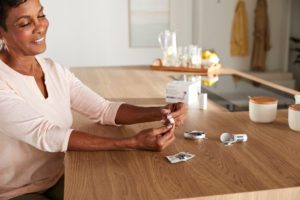 The Centers for Disease Control and Prevention (CDC) states that 34.2 million people have diabetes, which is 10.5% of the US population. It’s the seventh leading cause of death in the United States and the number one cause of adult blindness, lower-limb amputations, and kidney failure.
The Centers for Disease Control and Prevention (CDC) states that 34.2 million people have diabetes, which is 10.5% of the US population. It’s the seventh leading cause of death in the United States and the number one cause of adult blindness, lower-limb amputations, and kidney failure.
It is important to understand what diabetic supplies are necessary to keep your blood glucose levels in check when newly diagnosed — including the lancet use for blood sugar testing.
What is Diabetes?
When you have diabetes, your body is either not producing enough insulin or responding properly to it. This creates a build-up of blood sugar in the bloodstream, leading to serious health complications if not monitored and regulated.
There are 1.5 million new diagnoses for diabetes each year. And, in the last twenty years, the number of adults diagnosed each year has more than doubled. As a result, home blood glucose testing is an essential part of life for a person with diabetes. In addition, certain supplies are necessary for testing.
Diabetes Supplies That You May Need:
- Lancets
- A glucose meter
- Glucose tablets
- Test strips
The first item on the list is the key to getting a blood sample to test.
What is a Lancet?
A Lancet is a tool used to puncture the skin (usually the fingertip) and produce a small blood sample for glucose level testing. Lancets typically are surgical steel and encased in plastic to keep them sterile until it comes time to use one.
Lancets come in a variety of shapes and sizes, too. Different types of lancets are made for smaller or bigger hands and softer or more calloused skin.
Lancing devices use a spring that releases the lancet automatically, creating a small puncture wound. By design, they are quick and as painless as possible to make day-to-day life easier for those who test their sugar regularly.
What to Look For When Buying a Lancet
There are a few things to ask yourself when buying a lancet.
- Is it safe? Ensure that the lancet you choose is FDA approved and that it’s coming from a reputable source. Never buy used or unsealed lancets.
- Is it comfortable? If you feel uncomfortable when using a lancet, consider a different gauge or lancing device. The pressure and size of your finger prick can be adjusted to fit your skin’s specific needs.
- Is it producing enough blood to test? This is one of the most important considerations. Lancet gauge size can affect how much blood is being drawn at a time. Make sure to choose a size that is still puncturing deep enough to pull a necessary sample size for proper testing.
Where to Buy a Lancet
Using the Simply Medical search and filter feature, you can sort products by brand, color, rating, or price range. You can even sort by where on the body you wish to target (fingertip or heel). You can also view the lancet’s gauge and fixed depth. For example, if you have a latex allergy, you can filter out lancets that are not latex-free.
With Simply Medical, you can find a wide variety of lancets that will meet both your wants and needs.

